HOE-DYLAN-5 Cruise Blog
By Shimi Rii et. al.
July 31, 2012
Back in Honolulu with our land legs, here's a look back at the last 10 days of HOE-DYLAN V.
Alone in the North Pacific
Shortly after the last update, the scientists and crew aboard the R/V Kilo Moana
entered a "near-complete isolation" period during which satellite inter- and intra-web
ceased our connection to the outside world. We could receive email through the shipboard
intra-net but could not send out any information in reply. As we adjusted to using our
smartphones purely as alarms, science operations continued on, business-as-usual.

|
|
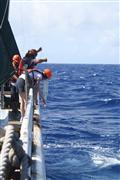
|
| Brian Burkhardt from the White Lab at OSU sampled from his
particulate organic matter (POM) addition experiment.
|
| Simone Moos from the Boyle Lab at MIT continued to take
daily automatic trace element (ATE) samples to look at the temporal variability of
dissolved, colloidal, and particulate iron and lead.
|
Burst Sampling
One of the goals of the HOE-DYLAN expedition is to determine the correct time scales at
which important processes occur - to characterize the dynamics of populations and their
biogeochemical pathways.
"We've concluded that the only way to figure this out is to look at some part of the
ocean over time in a fixed space ... if you look over the right time scales, or maybe
even oversample the time scales by being out there longer than you need to be, then
you can start seeing what these forcing functions really are," Dave Karl said to me
prior to the expedition. Oversampling the time scales means not just to be out at
Station ALOHA for 60+ days but also to invest many hours of intellect and physical labor
into "Burst Sampling."
"Burst Sampling" occurred from 12 midnight July 17 to 20:00 July 18, during which specific
samples were taken at 3 depths (25 m, DCM, and DCM isopycnal) every 4 hours. Bleary eyed
but determined, scientists took samples for dissolved nitrogen concentrations, photosynthetic
pigments, flow cytometric counts, photosynthetic physiology, Oxygen/Argon (for primary
productivity), and DNA/RNA.
"I am very excited about the data, it's tough to get resolution like that. It was torture ...
but the ice cream kept us going," reminisces Chris Schvarcz, a Ph.D. student in the Steward
Lab at UH Manoa studying the distribution and diversity of phytoplankton viruses.
What happened to the diatoms?
An example of microbial variability in the surface ocean is the observation of a "diatom
gathering" on July 17th. To my "Station ALOHA-frequenter" eye, the abundance of
diatoms in the net tow material was not representative of the typical surface net tow sample.
Yet, the fluorescence trace on the CTD revealed nothing suggestive of a bloom. By
July 20th, the surface ocean, which had been choppy and tumultuous due to wind swells,
calmed. Yet, the diatoms still persisted, having their annual summer gathering at Station
ALOHA.
On July 21st, the wind died, and the seas were even calmer. "We're going to see
Tricho," said Sam Wilson, our seasoned Chief Scientist. As we looked out over the
starboard hull, there it was: a trail of brown and orange hay, swirling in meandering
eddies of sawdust. A net tow sample revealed our beloved cyanobacteria, along with
copepods, and still a lot of diatoms (Hemiaulus, Rhizosolenia, Skeletonema).
Fortunately for us, Sam Wilson deployed a Nitrogen Array on July 21st, looking at high
resolution rate measurements of nitrogen fixation and hydrogen production. It will be
exciting to examine the depth distribution of the activities of the water column on this
Tricho bloom day.
A net tow sample on the last day of operations, July 26th, revealed that Trichodesmium
may have come and gone, but heterocyst-filled diatoms were still hanging out in their summer
playground. The collective data set obtained by HOE DYLAN V, such as daily surface rates of
primary production, bacteria production, and nitrogen fixation, as well as concentrations of
nutrients and trace metals, gas production, and the distribution and diversity of organisms
will undoubtedly provide a unique dataset to answer the questions proposed in the Prospectus
as well as in papers such as Dore et al. 2008 (Progress in Oceanography).
HOE-DYLAN V pau (done)
HOE-DYLAN V ended with the recovery and processing of 144 tubes of particle interceptor
traps on the sediment trap array. Lead by Tara Clemente and joined by many helping hands,
the process was smooth sailing. We are all excited to see the data from this experiment
that is truly the result of "hoe", "working together."
Twenty days. 3 Primary production arrays. 5 MITESS Vanes deployments. 1 Deep cast to
4500 m. 1 Nitrogen array. 1 12-depth sediment trap array. Countless optics casts,
CTD casts, samples. Immeasurable hours of lost sleep and hair-pulling agony of watching
water drip out of a filtration rig. But incomparably precious are our collective desire
and will to resolve the mystery of ALOHA.
Currently, the HOT crew is out on HOT-244 (HOE-DYLAN VI), and HOE-DYLAN VII will commence
on Sunday, August 5th.
"I think we did a great job - and it's the start of a great summer," said Sam Wilson today
with a big (relieved) smile on his face.
|
|
July 17, 2012
A Diatom Gathering?
Yesterday we threw in a small, 20 micrometer net for fun hoping to
isolate some Trichodesmium species. Unlike typical conditions, we
were surprised to see a relatively abundant population of diatoms:
Hemiaulus, Rhizosolenia, Skeletonema-like cells (check out
photos with heterocysts by Christina Johnson), and smaller, pennate diatoms! At
one time, my field of view on the macroscope (at the highest zoom
setting) showed ~20-30 pennates. In the meantime, the mixed layer
remains at ~ 60-70 m with large swells - and the CTD trace looks
nothing out of the ordinary. It will be interesting what the
collective data set including key parameters for nitrogen-fixing
symbionts such as iron, phosphate, nitrogen fixation rates, and
DNA/RNA will show in support of what we see through the scope! Stay
tuned!
|
|
July 14, 2012
What went in the water - Week 1 - HOE DYLAN V
CTD/Rosette sampler
Water was sampled at all hours during the day, starting from the Rate cast at
0400 to the Biogeochemical cast at 1600, with the busy 0800 cast and the 1200
Isopycnal cast in between. The 2000 and 0000 casts were frequented by those
needing large volumes for incubation experiments.

|

|
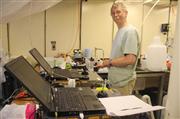
|

|
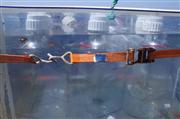
|
| Emily Estes is exploring the diversity of bacteria that
produce reactive oxygen species.
| Vanessa Michelou preps filters for DNA/RNA sampling.
| Zbigniew Kolber is measuring photosynthetic activity with
his FRRF (and dancing to Cake).
| Mary Hogan and Ariel Rabines are filtering for nifH gene
abundances and high throughput microarrays.
| Shimi Rii's nitrate and ammonium addition incubation
experiment.
|
Optics/Hyperpro
Twice daily, Benedetto Barone deploys the optics package and the Hyperpro to
characterize Station ALOHA's bio-optical properties and determine the relationship
between light and plankton.
GO-FLO
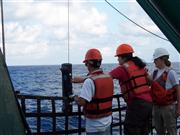

|
|
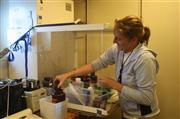
|
| Kelly Roe and Robin Schneider deploy the GO-FLO sampler
daily at 0700 at 3 depths.
|
| Kelly is measuring the concentration of superoxide in
the water column.
|
Vanes
On Wednesday, July 11, Boyle lab's Jess Fitzsimmons deployed 10 Vanes samplers at
175 m to obtain a total of ~ 15 L of contamination-free water. They are measuring
the distribution and size partitioning of Fe, Pb, and other trace metals.
PP Array
Church and Karl labs deployed the primary production array #1 on Thursday, July 12,
to measure rates of carbon fixation at standard depths (between 5-125m) during a
photoperiod.
Sediment Traps
Karl lab and collaborators deployed 144 particle interceptor traps (12 crossbeams)
on Saturday morning, which will stay out for the duration of the cruise. Different
trap types include live, dead, RNAlater, and screen or no screen.
|
|
July 9, 2012
The HOE-DYLAN V expedition set sail Sunday, July 8 at 0800 from Honolulu Harbor on the R/V Kilo Moana,
with 21 scientists from 7 institutions on board: 1 professor, 4 post-docs, 9 graduate students,
1 undergraduate, and 6 research associates. Though driven by individual research goals, we are
all Station ALOHA enthusiasts, working together ('hoe') to achieve the overall goal of resolving
hourly to weekly variability of physical and biogeochemical parameters in the North Pacific
Subtropical Gyre (NPSG). This research expedition follows an extensive study conducted on
HOE-DYLAN III, the Research Cruise for the 2012 C-MORE Summer Training Course. On HOE-DYLAN III,
the summer course students took daily measurements of a suite of biogeochemical parameters
mirroring the dataset from the 23-year-old HOT time-series, following it up with a high-frequency
tri-hourly sampling regime. Their data, presented on Friday, July 6, showed preliminary results
highlighting the importance of episodic changes in light and nutrients on the NPSG biological
community. Subtle, short-lived, non-steady state dynamics of the ocean are important for setting
the biological stage, everything from total rate of photosynthesis to the amount of fish that's
produced. We have now begun our occupation of Station ALOHA to resolve these dynamics.
After a safety briefing by Captain Rick, we were under way towards Station ALOHA. We arrived
around 1800 and immediately deployed two APEX drifting profiling floats from University of Washington
(Dana Swift and Ken Johnson) that provide us with near real-time profiles of nitrate, oxygen,
salinity, temperature and density. At 1900, we deployed the rosette sampler package with a CTD
and ADCP as a training cast to familiarize the scientists on board with the process of prepping
the rosette sampler, deployment, and running the CTD console software. Nitrite samples were
collected by UH research associate Ken Doggett to determine the nitrite maximum, the data for which
is being processed today.
There is much exciting science to look forward to in the next 20 days. A snapshot of individual
interests is as follows:
The Karl Lab (UH) is looking at ocean biogeochemistry and fluxes as well as various gases such as
methane, nitrous oxide, hydrogen associated with nitrogen fixation, nitrite, and O2/Argon as a
measure of primary production. The Boyle Lab (MIT) is measuring dissolved iron and lead
concentrations in the surface waters to determine dust inputs of iron. In addition, a group of
scientists from Colorado School of Mines are looking at reactive oxygen species and hydrogen
peroxide, and collaborating with an MIT scientist to cultivate bacteria that produce reactive
oxygen species.
The Church Lab (UH) aims to characterize daily rates of surface primary production, bacterial
production, and nitrogen fixation. Benedetto Barone, in collaboration with the Church Lab and
Letelier and White Labs (OSU), will be the Optics guy - looking at the attenuation of multiple
wavelengths through the water column. The White Lab is also conducting a particulate organic
matter (POM) remineralization experiment.
Microbial diversity work is also being conducted. The Church Lab (UH) is looking at Archaea and
photosynthetic picoeukaryote diversity and phytoplankton responses to addition of nitrate and
ammonium. There will also be a look at diatom-associated heterocystous cyanobacteria and
Crocosphaera in collaboration with John Waterbury. The Zehr Lab (UCSC) is conducting incubation
experiments with different nitrogen species to look at DNA/RNA and microarray data. The Steward
Lab (UH) aims to characterize the diversity of viruses associated with phytoplankton, and the
Rappé Lab (UH) is collecting DNA/RNA for 16S pyrosequencing. The DeLong Lab (MIT) will obtain
metatranscriptomics data for the NPSG community, and the Chisholm lab (MIT) is further assessing
Prochlorococcus dynamics.
Stay tuned for updates on the exciting science going on at 22o 45'N, 158o 00'W!
|
|

